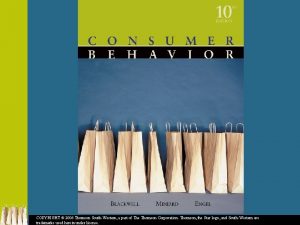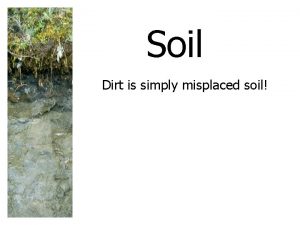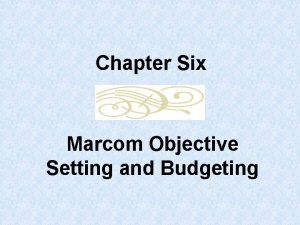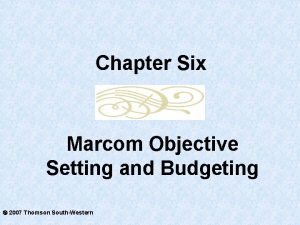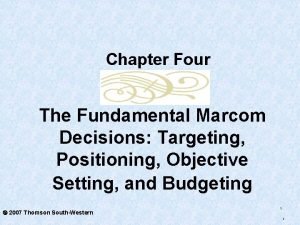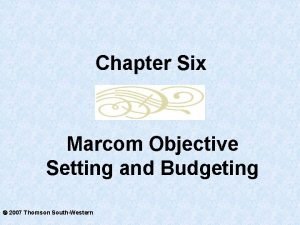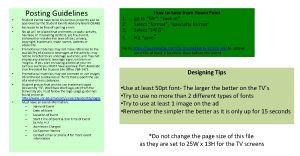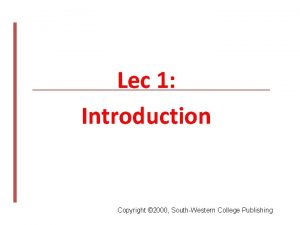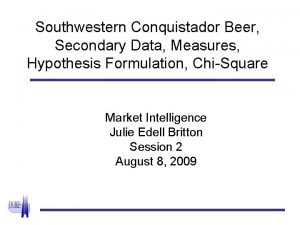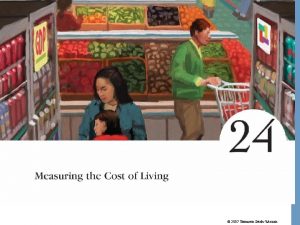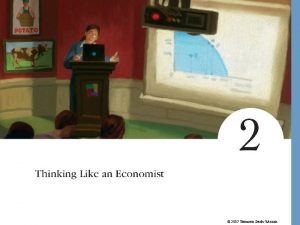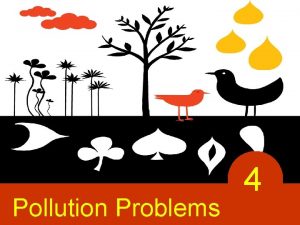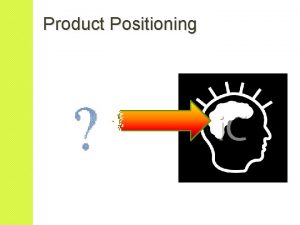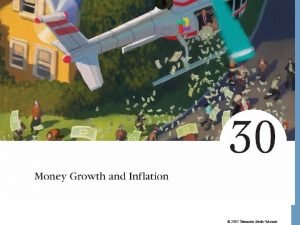Chapter Five Marcom Positioning 2007 Thomson SouthWestern Chapter



























- Slides: 27

Chapter Five Marcom Positioning 2007 Thomson South-Western

Chapter Five Objectives • Introduce the concept and practice of brand positioning • Explain that positioning involves the creation of meaning and that meaning is a constructive process involving the use of signs and symbols • Give details about how brand marketers position their brands by drawing meaning from the culturally constructed world. 2

Chapter Five Objectives • Describe how brands are positioned in terms of various types of benefits and attributes. • Explicate two perspectives that characterize how consumers process information and describe the relevance of each perspective for brand positioning. 3

Positioning In Theory: Creating Meaning • A brand’s positioning represents the key feature, benefit, or image that it stands for in the target audience’s collective mind. 4

Positioning Statement A positioning statement for a brand is the central idea that encapsulates a brand’s meaning and distinctiveness compared to other brands. 5

Semiotics “The study of signs and the analysis of meaning-producing events. ” Meaning is a constructive process that is determined as much by the communicators as by the receivers of the message. 6

The Meaning of Meaning The perceptions (thoughts) and affective reactions (feelings) to stimuli evoked within a person when presented with a sign in a particular context 7

The Meaning of Meaning Perceptual Field The sum total of a person’s experiences during his or her lifetime. 8

Meaning Transfer: From Culture to Object to Consumer Through socialization, people learn cultural values, form beliefs, and become familiar with the physical manifestations, or artifacts, of these values and beliefs. 9

Positioning in Practice: The Nuts and Bolts • Brand positioning is essential to a successful Marcom program. • A good positioning statement should: – Reflect a brand’s competitive advantage – Motivate customers to action 10

Outcomes of Proposed Positioning 11

Benefit Positioning with respect to brand benefits can be accomplished by appealing to any of three categories of needs. Functional Needs Symbolic Needs Experiential Needs 12

An Appeal to Symbolic Needs Products that potentially fulfill a consumer’s desire for self-enhancement, group membership, affiliation, altruism, and belongingness 13

Attribute Positioning A brand can be positioned in terms of a particular attribute or feature, provided that the attribute represents a competitive advantage and can motivate customers to purchase that brand rather than a competitive offering. 14

Non-Product Related: Usage and User Imagery • Brands can also be positioned in terms of their unique usage symbolism or with respect to the people who use them. 15

Examples of Repositioning a Brand “Flame-Broiled” Vs. “Fire-Grilled” “Oil of Olay” to Olay 16

Implementing Positioning • Consumer Processing • Hedonic, Experiential Model (CPM): Model (HEM): views information and consumers’ choice are seen as a processing of marcom rational, cognitive, messages and systematic and behavior as driven by reasoned process. emotions in pursuit of fun, fantasies and feeling. 17

CPM The Consumer Processing Model (CPM) 18

Perceptual Encoding 1. Feature analysis: Initial stage whereby a receiver examines the basic features of a stimulus 2. Active synthesis: Beyond examining physical features, the context or situation plays a major role in what meaning is acquired 19

Miscomprehension 1. Messages themselves are sometimes misleading or unclear. 2. Consumers are biased by their own preconceptions and thus “see” what they choose to see 3. Processing of advertisements often takes place under time pressures and noisy circumstances. 20

Elements of Memory involves the related issues of what consumers remember about marketing stimuli and how they access and retrieve information when making consumption choices 21

Elements of Memory • Sensory stores(SS): – Information is rapidly lost unless attention is allocated to the stimulus • Short-Term Memory(STM): – Limited processing capacity – Information not thought about or rehearsed will be lost in 30 seconds or less 22

Elements of Memory • Long-Term Memory (LTM): – A virtual storehouse of unlimited information – Information is organized into coherent and associated cognitive units called schemata, memory organization packets, or knowledge structures – The marketer’s job is to provide positively valued information that consumers will store in LTM 23

Two Types of Learning Strengthening of linkages among specific memory concepts – repeating claims, presenting them in a more concrete fashion and being creative in conveying a product’s features • Establishing entirely new linkages 24

Search and Retrieval of Information • Information that is learned and stored in memory only impacts consumer choice behavior when it is searched and retrieved • Retrieval is facilitated when new information is linked with another concept that is well known and easily accessed • Dual-Coding Theory: Pictures are represented in memory in verbal as well as visual form, whereas words are less likely to have visual representations. 25

A CPM Wrap-Up • The rational consumer processing model (CPM) and the hedonic, experiential model (HEM) are not mutually exclusive. 26

The HEM perspective • People often consume products for the fun of it or in the pursuit of amusement, fantasies, or sensory simulation • Products are subjective symbols that precipitate feelings and promise fun and the possible realization of fantasies • The communication of HEM-relevant products emphasizes nonverbal content or emotionally provocative words and is intended to generate images, fantasies, and positive emotions and feelings 27
 Thomson southwestern
Thomson southwestern Mitochondria
Mitochondria Thomson higher education 2007
Thomson higher education 2007 Marcom calendar
Marcom calendar Marcom objectives
Marcom objectives Marcom objectives
Marcom objectives Marcom objectives
Marcom objectives Behaviorgraphics segmentation
Behaviorgraphics segmentation Objective setting and budgeting decisions must be
Objective setting and budgeting decisions must be Marcom implementation decisions
Marcom implementation decisions Unr marcom
Unr marcom Asl marcom
Asl marcom Marcom
Marcom Marcom
Marcom Southwestern community college
Southwestern community college South-western college publishing
South-western college publishing Kappa alpha psi southwestern province
Kappa alpha psi southwestern province Southwestern college publishing
Southwestern college publishing Southwestern college cincinnati ohio
Southwestern college cincinnati ohio 625/2
625/2 Southwest province kappa psi
Southwest province kappa psi Southwestern province kappa alpha psi
Southwestern province kappa alpha psi Kappa alpha psi southwestern province
Kappa alpha psi southwestern province Southwestern educational publishing
Southwestern educational publishing South western college publishing
South western college publishing Southwestern province
Southwestern province Symplicity rutgers
Symplicity rutgers Sinai baltimore ophthalmology residency
Sinai baltimore ophthalmology residency
